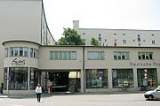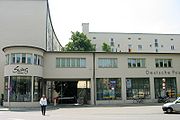
Robert Vorhoelzer
Encyclopedia
'Robert Vorhoelzer was a German architect
.
 Bavarian architect Robert Vorhoelzer belongs to the classical modernist school of architecture that is otherwise rather underrepresented in Bavaria. Most of his works were built when Vorhoelzer was Oberbaurat of the Bavarian postal administration. Together with Robert Poeverlein he founded the "Bayerische Postbauschule". In the early stages of his work, such as at the post office Penzberg
Bavarian architect Robert Vorhoelzer belongs to the classical modernist school of architecture that is otherwise rather underrepresented in Bavaria. Most of his works were built when Vorhoelzer was Oberbaurat of the Bavarian postal administration. Together with Robert Poeverlein he founded the "Bayerische Postbauschule". In the early stages of his work, such as at the post office Penzberg
or the post office on Ismaninger Straße in Munich, the influence of the "Heimatstil" was dominant. But later Vorhoelzer built many modern and functional buildings (post offices, depots, apartment buildings for postal staff etc.) in the style of Neue Sachlichkeit
. These include, for example, the post office on Tegernseer Straße ( "Tela-Post") in Munich-Obergiesing, the post office building at Goethe Platz or the post office at Harass place in Munich-Sendling (1931–32), a white office building with a rotunda and high rise apartment blocks in the background. The harmonious integration of his buildings in the surrounding urban landscape proves Vorhoelzer's ability as a city planner. In particular, the appearance of the Arnulfstraße in Munich owns much to the numerous Vorhoelzer buildings.
In 1930, Robert Vorhoelzer has been appointed professor at the Technical University of Munich
. With the beginning of the Third Reich he lost his chair accused of being an "architectural bolshevist
", although he resumed working as an architect and, for example, built the church "Mary Queen of Peace" in Obergiesing (1936–37). On the eve of WWII, Vorhoelzer emigrated to Turkey, from where he has been expelled in 1941 due to an allegation of espionage for Germany.
After the war, he retrieved his chair, but in 1947 he hast been suspended again for six months after Nazi allegations concerning the date of the Turkish exile. In the post-war debate on the reconstruction of Munich, Vorhoelzer pointed out that parts of the city had been in need of rehabilitation even before the war. He called for a radical new development plan, in which Flachbauten low-rise and high-rise buildings played an important part. He also had been ahead of his times in his request to discuss the reconstruction in public. In 1952, Vorhoelzer retired and two years later, he died at the age of 70 years after an operation.
His last major work was the monumental parish church of St. Joseph in Dingolfing
, which had only been completed 1954 to 1956 after his death. For this hall-type church, he applied motives that were already present in the church Giesinger "Mary Queen of Peace".
Architect
An architect is a person trained in the planning, design and oversight of the construction of buildings. To practice architecture means to offer or render services in connection with the design and construction of a building, or group of buildings and the space within the site surrounding the...
.

Penzberg
Penzberg is a town in the Weilheim-Schongau district, in Bavaria, Germany. It is located near Munich, and had a population of 16,126 in 2005. A historic coal mining town, Penzberg today is known for its pharmaceutical industries.-History:...
or the post office on Ismaninger Straße in Munich, the influence of the "Heimatstil" was dominant. But later Vorhoelzer built many modern and functional buildings (post offices, depots, apartment buildings for postal staff etc.) in the style of Neue Sachlichkeit
New Objectivity (architecture)
The New Objectivity is a name often given to the Modern architecture that emerged in Europe, primarily German-speaking Europe, in the 1920s and 30s. It is also frequently called Neues Bauen...
. These include, for example, the post office on Tegernseer Straße ( "Tela-Post") in Munich-Obergiesing, the post office building at Goethe Platz or the post office at Harass place in Munich-Sendling (1931–32), a white office building with a rotunda and high rise apartment blocks in the background. The harmonious integration of his buildings in the surrounding urban landscape proves Vorhoelzer's ability as a city planner. In particular, the appearance of the Arnulfstraße in Munich owns much to the numerous Vorhoelzer buildings.
In 1930, Robert Vorhoelzer has been appointed professor at the Technical University of Munich
Technical University of Munich
The Technische Universität München is a research university with campuses in Munich, Garching, and Weihenstephan...
. With the beginning of the Third Reich he lost his chair accused of being an "architectural bolshevist
Bolshevik
The Bolsheviks, originally also Bolshevists , derived from bol'shinstvo, "majority") were a faction of the Marxist Russian Social Democratic Labour Party which split apart from the Menshevik faction at the Second Party Congress in 1903....
", although he resumed working as an architect and, for example, built the church "Mary Queen of Peace" in Obergiesing (1936–37). On the eve of WWII, Vorhoelzer emigrated to Turkey, from where he has been expelled in 1941 due to an allegation of espionage for Germany.
After the war, he retrieved his chair, but in 1947 he hast been suspended again for six months after Nazi allegations concerning the date of the Turkish exile. In the post-war debate on the reconstruction of Munich, Vorhoelzer pointed out that parts of the city had been in need of rehabilitation even before the war. He called for a radical new development plan, in which Flachbauten low-rise and high-rise buildings played an important part. He also had been ahead of his times in his request to discuss the reconstruction in public. In 1952, Vorhoelzer retired and two years later, he died at the age of 70 years after an operation.
His last major work was the monumental parish church of St. Joseph in Dingolfing
Dingolfing
Dingolfing is a town in Southern Bavaria, Germany. It is the seat of the Landkreis Dingolfing-Landau.- History :The area now called Dingolfing was first mentioned in Tinguluinga in the year 833....
, which had only been completed 1954 to 1956 after his death. For this hall-type church, he applied motives that were already present in the church Giesinger "Mary Queen of Peace".

